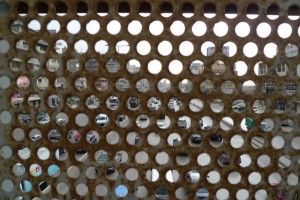Upon arrival in Beirut, the most natural thing for us to do was to pick up a map book. In those first hectic weeks, Zawarib Beirut became, if not a trusted guide at least a first resort. True it was published a decade ago so some major junctions are missing, but it was a good start to making sense of the hodge podge of poorly signed potholed streets which remain permanently under construction. When people asked how we were getting on finding our way round, we credited Zawarib Beirut.
“A plan of Beirut?” they exclaim astounded. “Does that even exist?” Sometimes we even have to show them. They leaf through fascinated, as if it were a map of some fictional place. They are baffled by this strange flat cold calm representation of their overheated, writhing, shifting streets and amazed that one would attempt to freeze them in time like one of those display boards of pinned insects.
The map book still gets a lot of use, but we have learnt that the key element to understanding directions is learn what the popular landmarks are – not those which stand out to us – and what the locals call them. Not what the map or even the signposts indicate, but the general age-old consensus of what is what. The Chevrolet dealer moved away from Chevrolet Roundabout years ago and there’s no sign to commemorate its presence, save the one in the general consciousness which is set to outlive any memory of the dealer. Sharing this labelled vision of things makes finding places possible in a world without addresses.
This approach is strikingly similar to the way people pinpoint people. Acquaintances are not perceived on an individual level but rather on a family level. Referring to another person starts at the family name, which is more of a clan title, especially if its a very common name like Haddad. Then it is usually possible to identify the branch of the clan by geographic location. Next the aim is to find a link between the target and a well-known member of that offshoot of the clan (the wife of the son of the brother of the Haddad who was assassinated – which one? – his first wife – no, which one who got assassinated?). Such discussions involve listing every known relative at home and abroad, dead or alive, until the entire family tree is conjured up and hangs suspended in the shisha smoke, like a virtual databank of common memory, complete with details on the trade, medical history and bad character traits of each one.
In Lebanon like nowhere on earth, no man is an island. Add the trading instinct of the Phoenecians to a small-town intimate knowledge of each family and the result is a highly effective socio-professional network which no modern online networking tool can hold a candle to. The relative connections between members define them more than their actual name, in exactly the same way as a particular geographical point is defined not by its address – no-one uses addresses in Lebanon – but by a mapping to certain favoured landmarks. Thus the General Security Bureau is listed as Near the Museum, Near the Ministry of Public Health. The Ministry of Labour, on the other hand can be found in Mcharafieh, Near the Arab Bank. And if you cannot find the particular branch of the Arab Bank in the neighbourhood of Mcharafieh then…you’re not Lebanese.

Great article! First time when i was in Beirut, I’ve asked for a map and people told me many times “There’s not such a thing here”. Now I know what I need.
I’ve noticed that people don’t use addresses and i was wondering how does the Post work there?!
To get around the postal problem, many people hire a P.O. Box in their local post office by the year. But local post is reasonably reliable largely on the basis of building names and a great deal of chatting with the neighbours. Getting takeaway delivered is quite a rigmarole though!
I travel to Kuwait too and it’s the same there where people tend to name a famous landmark instead of streets. They have a map with street names but tell that to a taxi driver or a locale and you get a blank stare. So having food delivered, I have to say “After the big dawar (roundabout), turn left and it is in front of Prada Londry” – yes, that’s the name and how it’s spelt.